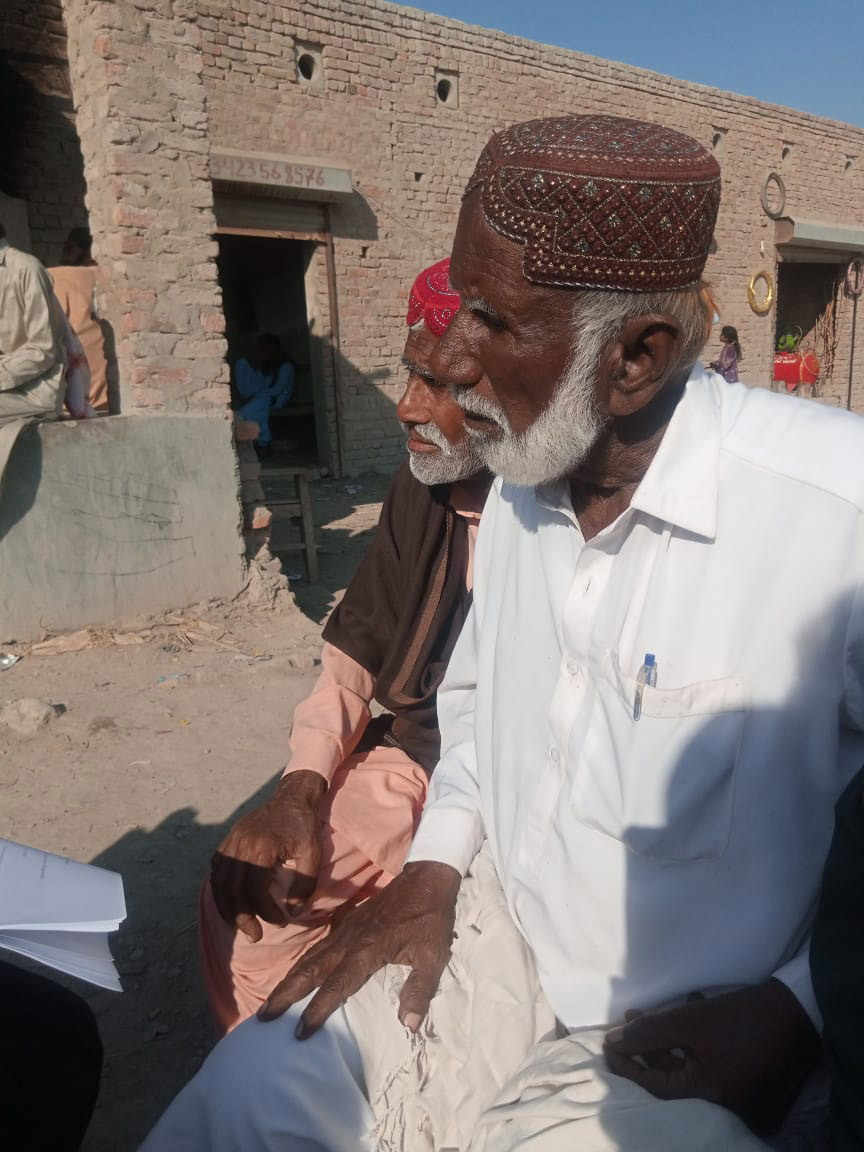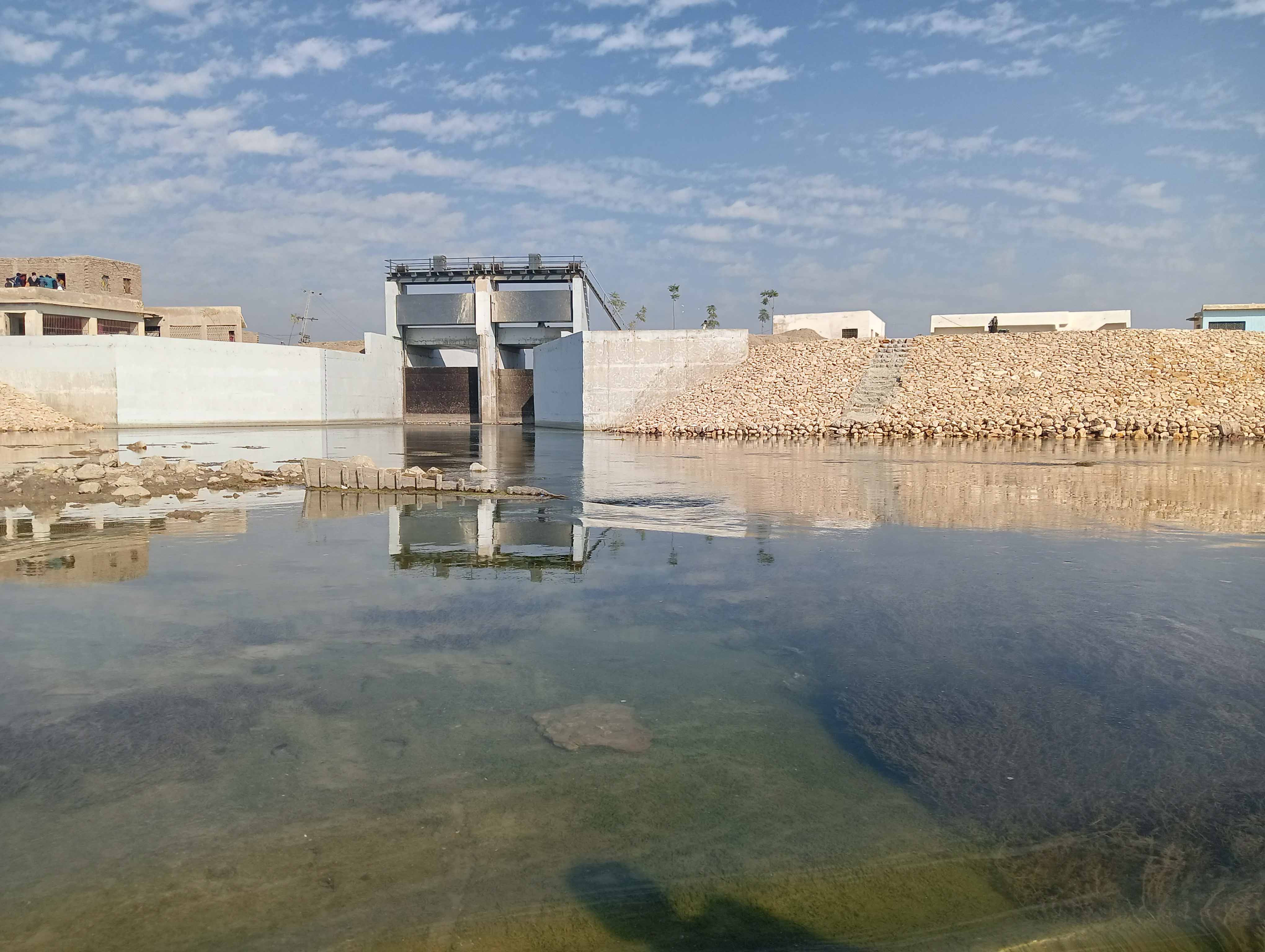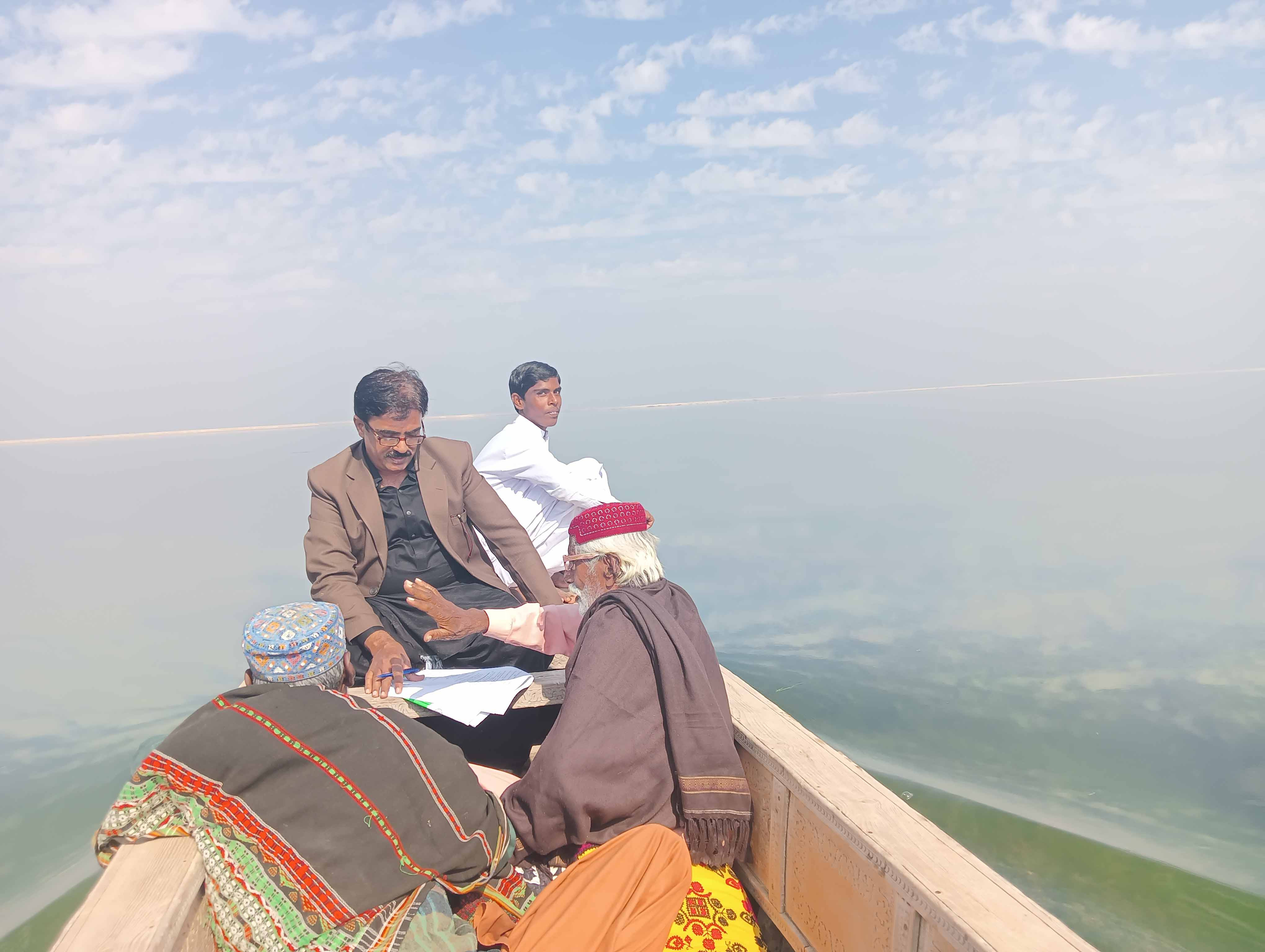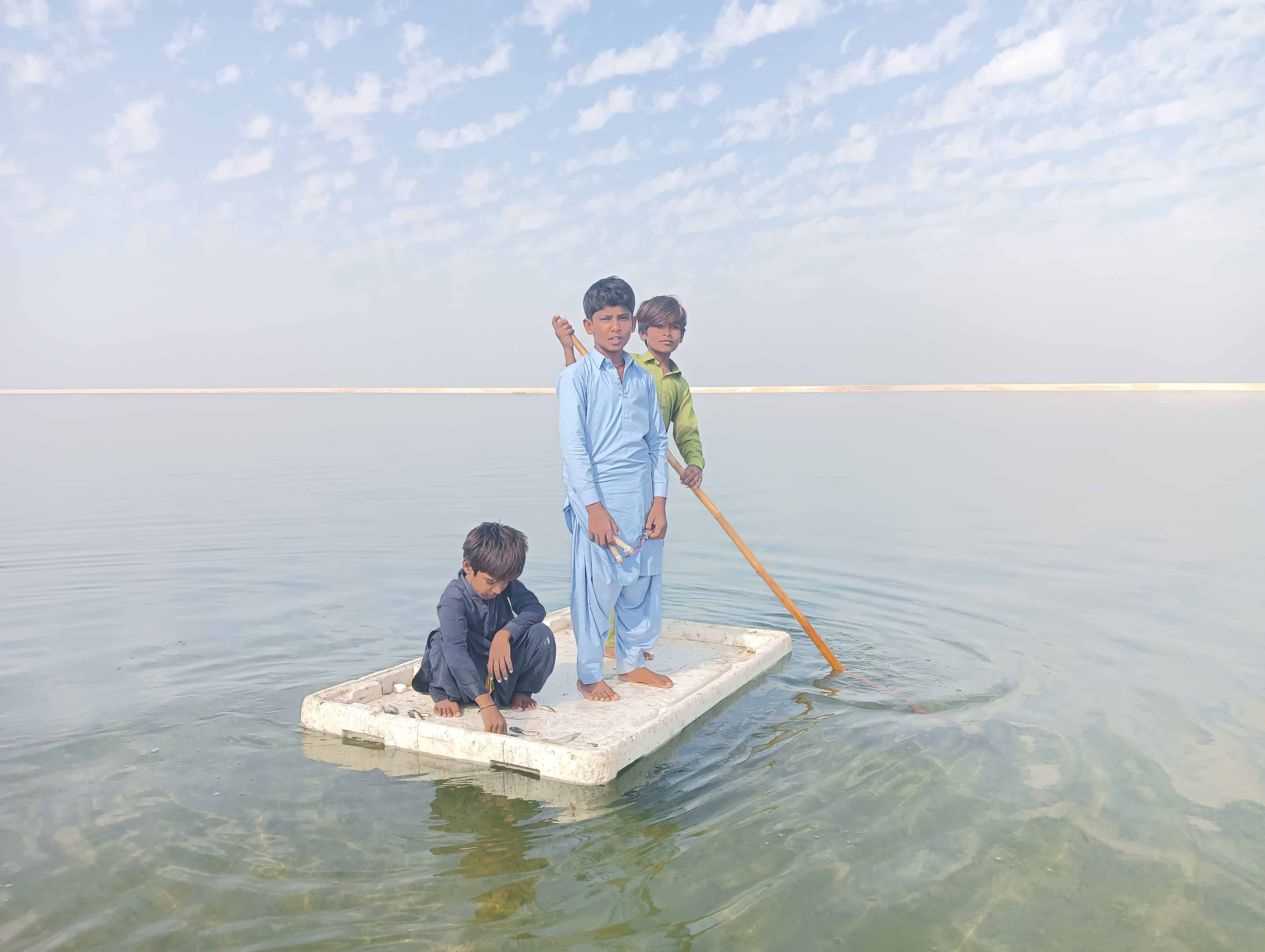Last month, with a couple of friends from village Bajara located south of Manchhar, I left for our much anticipated-Manchhar lake trip at around 10.30 am. The necessary arrangements were already made with a local fisherman, Ahmed Mallah, to take us through Manchhar on his boat. It didn’t take us long to reach village Gaib Pir and after parking our car, we were in the boat by 11.00 am, which took us to the lake through the Gaib Pir Wah, a narrow and deep irrigation canal fed by Manchhar.
In about half an hour, we had traversed 4-5 kilometers by boat to enter the endless and massive waters of Manchhar.

The gigantic lake with huge health issues
Being my first trip to the lake, I was speechless to see the serenity, width and breath of the lake as the boat moved into the greenish [because of the rich growth of some saline water species of some grass and weeds under water], clean and transparent Manchhar waters. One could easily see the bottom of the lake and the thorny and sticky grass under the still waters that were cold as it was past mid-December and the northern winds blew gently. As the boat ventured further, the width and breadth of the lake became clearer to us. In just 15 min of moving into the lake, we could see only the bank of the lake where we had begun our journey from.
Even though it is the largest lake in Pakistan in terms of area, Manchhar’s depth is relatively shallower. “It is 2.5 to 3.75 metres deep on average,” says Ghulam Hussain Mallah, a veteran fisherman aged around 60 years. “But it may be seven to eight feet deep at some places.” Ahmed Mallah, had brought Ghulam Hussain with him on our request to tell us about Manchhar.
I sat with both of them at one end of the boat while my friends sat on the other. Presently contaminated and turned saline by the infamous Right Bank Outfall Drain (RBOD), Manchhar was once the largest fresh water lake in Pakistan. It lies around 17 kilometers west of Sehwan town, flanked by Kirthar Hills on its west, Johi town on northwest, Bubak and Bhan Saeedabad on its north and Lakki hills on the south.
I noticed the gloomy faces of both the fishermen and felt that it is not the lake that had turned saline, but rather the people of this vast lake who have become bitter as they have been robbed not only of their economies, their floating boathouses and their once vibrant fish business. It seems that even their souls have been snatched away from them. Along with the contamination of Manchhar’s waters, the fishermen’s hearts have also become poisoned. They gaze at the lake as I notice their parched and soulless demeanour.
The government, political parties, non-government organisations and politicians have all turned deaf ears to the lake, its people and the very lush culture that it once was.
We also wanted to explore the boat villages afloat its waters. “A boat village represents the true essence of Mohanna culture of this water body,” says Ghulam Hussain. The deeper Ahmad took us into the lake, the more enchanted we were with its serenity and elegance.
An hour had passed by and as I stood up in the boat and look around, I was unable to see any bank of the lake, there was only water around us. I saw a casual solo flight of the Pacific Gull locally called Keno. I asked our guides if we were in the centre of the lake now. Both shook their heads. “No, we are still on the south-east corner of the lake,” explains Ghulam Mallah. “The centre of the lake lies on our far north. The lake spreads to more than 500 sq-km during monsoons. As there was unprecedented monsoon last year, the lake has crossed its actual borders. However, during droughts it shrinks to as little as 36km. We are still at the encroached area of Manchhar as is shown by the depth of water here. It is not more than four feet deep here.”

The Mohannas
Our boat was moving towards Manchhar embankment near Bubak village. After a wonderful voyage of around other 40 minutes inside Manchhar, we spotted a village of boathouses situated near Manchhar embankment just east of Bubak.
Ahmed cautioned us that going directly to the village might offend them because of the strict purdah culture followed in this fishing community. He made some phone calls but failed to connect with anyone.
“Since it is Friday, the village men might have gone to Bubak to collect their dues from the contractors and purchase rations for their families,” he told us.
Meanwhile, we saw a little makeshift boat with three Mohanna children with catapults in their hands approaching us. Ahmed asked them about some of his acquaintances there but they seemed to have gone away for the day.

The Bund Manchhar village
We then decided to head towards the Bund Manchhar village (near Bubak) to meet some Mohannas, as it was a central, commercial village of Manchhar and not far from us. Since the village is situated on Manchhar ‘embankment’ meaning ‘bund’ in Sindhi, it is called Bund Manchhar village.
We expected to reach our destination within fifteen minutes as the white-stone-embankment was clearly visible but as our boat resumed its journey, it took us a lot longer to reach our desired destination because the fishermen had miscalculated the distance. When we finally reached the tail regulator of Danister Canal near the Bubak village, the boat was parked near the bund regulator and we got off at Bund Manchhar village, close to the historical Bubak village.
On the embankment near the regulator, is a fish market housed in an old and shabby government-style building but it was closed as it was a Friday. According to Ahmed, this place served as the central fish market where contractors from across Pakistan purchase fish. As we walked past the market building, we could see over a dozen deep freezers lying inside. In addition to the fish market, there were some scattered shops selling grocery, vegetables, poultry, fish and pakorra and tea.
Most of the small tea stalls were packed with crowds of fishermen and local villagers. Just down the embankment on Bubak road, we stopped at a relatively larger tea stall offering seating on some wooden benches in the warm sun.
While we waited for our tea, Ahmed had arranged for a fisherman-activist named Hoat Khan to talk to us. Around 65 years old, he had a dark, weatherworn skin and bright eyes. He spoke to us about Manchhar, Mohannas and their problems. According to him, the Bund Manchhar village had some 80 houses, 15 to 20 shops, a primary school, and a government dispensary. Most of houses were katcha with no basic facilities such as electricity, gas and water. Manchhar water being saline, people had to purchase drinking water.
As we chatted, some other fishermen joined us. “Manchhar is an ancient, natural lake present since time immemorial,” says Mustafa Mirani, a fisherman. “Our forefathers have been here since centuries. It is believed that Manchhar is older than 10,000 years. It is mentioned in the memoirs of ancient Greek, Chinese, Arab and British travellers and historians.”

RBOD – the troublemaker
According to the fishermen, since centuries Manchhar enjoyed prosperity until the saline and contaminated waste waters from the agricultural lands of Guddu and Sukkur barrage catchment areas was drained into it in 1991-92, through the 111km long RBOD, which is the culprit of all troubles faced by Manchhar, its freshwater ecosystem and the human population. It has put the very existence of the lake into peril. Before construction of RBOD, all sources of water flowing into Manchhar were sweet. The fishermen agreed that the pre-RBOD period was one of pomp and prosperity.
During its glorious days, the population of Manchhar Lake was estimated to be around 100,000, but over the past few years, outward migration has intensified, mainly due to the deteriorating quantity of catch and diminishing opportunities for agriculture and other livelihoods. Of the 2,000 fishing boats, the number has reduced to less than 50. When Manchhar waters were untroubled, there were more than 2,000 floating boathouses, but presently there are less than 100 houses along the Manchhar bund. If the situation does not improve, the floating boathouses and the centuries-old culture of Manchhar will also vanish.
Contaminated and toxic water continuously being drained into the lake has completely degraded its ecosystem and biodiversity. Once it was centre for production of the lotus flower and its root known locally as beh, but not anymore. The migratory birds Manchhar was once home to more than one hundred birds of different species including coots, cranes, ducks, geese, herons, ibis, mallards, and wigeons etc., but presently only three to four types of birds may be found as most of the migratory birds of the Indus flyway now flock to other destinations for their survival and nurture.
“During winter when the water gets better because of decreased flow of drained waste water in the RBOD, five to six species of fish are found whereas in summer, the only species found in the entire lake is pomfret as it can survive in the saline water,” says Khan. “Even at the time of RBOD construction, there were more than 52 indigenous species of fish in Manchhar including pomfret, mori (cirrhinus mrigala), theila (catla) and rohu (labeo rohita), olive barb and many other freshwater species of fish.”
All fishermen organisations and Manchhar experts agree that RBOD is the solely responsible for the destruction of Manchhar; and therefore diverting its saline water away from Manchhar is the only sustainable solution available for its revival.

Why RBOD II will not work
Proposals for RBOD II as a solution face scepticism. Several different options are available for the diversion of 3,300 cusecs water of RBOD. The major options include construction of a link canal to siphon water across the Indus into LBOD; constructing RBOD II from Sehwan to the Arabian Sea through Gharo creek; and building the large reservoir ponds in the vast foothills of Kirthar on the west of Manchhar. Mirani strongly advocates that the construction of RBOD II siphon to drain water from Manchhar to the sea is not feasible. Despite being inexpensive, they are not feasible as shown by the 2010 super floods and the unprecedented rains in 2022. Had RBOD II siphon been constructed and made functional, they would have been washed away by the super floods of 2010. Even if there are no floods and the RBOD is not washed away, its flow alongside the Indus would contaminate the sweet water of the Indus through seepage. There is no solution to this hazard. Hence, RBOD II is technically and structurally an unfeasible and unsafe project.

Ponds and reservoirs
“The only feasible solution to divert the water of RBOD is construction of reservoir ponds at the vast and barren foothills of the Kirthar mountains,” says Mirani. Similar experiments have been a success in countries such as Egypt. Feasible locations can be identified on the western side of Manchhar for the construction of the large reservoir ponds and dams where saline water species of fish can be farmed as well. Secondly, these reservoir ponds and dams can be developed into tourist destinations to promote eco-tourism in the area linked with Gorakh Hill Stations, Kuttay Ji Qabar (Grave of dog) Bado Jabbal, Sehwan and other tourist attractions in Kirthar.
Dr Ali Gul Khushik teaches economics at University of Sindh, Jamshoro
All facts and information are the sole responsibility of the writer
